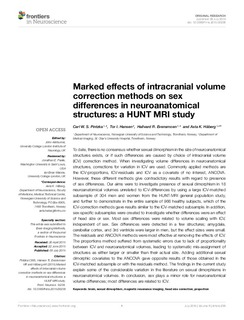| dc.contributor.author | Pintzka, Carl Wolfgang Schøyen | |
| dc.contributor.author | Hansen, Tor Ivar | |
| dc.contributor.author | Evensmoen, Hallvard Røe | |
| dc.contributor.author | Håberg, Asta | |
| dc.date.accessioned | 2015-11-23T10:43:19Z | |
| dc.date.accessioned | 2016-04-20T13:39:01Z | |
| dc.date.available | 2015-11-23T10:43:19Z | |
| dc.date.available | 2016-04-20T13:39:01Z | |
| dc.date.issued | 2015 | |
| dc.identifier.citation | Frontiers in Neuroscience 2015, 9 | nb_NO |
| dc.identifier.issn | 1662-453X | |
| dc.identifier.uri | http://hdl.handle.net/11250/2386549 | |
| dc.description.abstract | To date, there is no consensus whether sexual dimorphism in the size of neuroanatomical structures exists, or if such differences are caused by choice of intracranial volume (ICV) correction method. When investigating volume differences in neuroanatomical structures, corrections for variation in ICV are used. Commonly applied methods are the ICV-proportions, ICV-residuals and ICV as a covariate of no interest, ANCOVA. However, these different methods give contradictory results with regard to presence of sex differences. Our aims were to investigate presence of sexual dimorphism in 18 neuroanatomical volumes unrelated to ICV-differences by using a large ICV-matched subsample of 304 men and women from the HUNT-MRI general population study, and further to demonstrate in the entire sample of 966 healthy subjects, which of the ICV-correction methods gave results similar to the ICV-matched subsample. In addition, sex-specific subsamples were created to investigate whether differences were an effect of head size or sex. Most sex differences were related to volume scaling with ICV, independent of sex. Sex differences were detected in a few structures; amygdala, cerebellar cortex, and 3rd ventricle were larger in men, but the effect sizes were small. The residuals and ANCOVA methods were most effective at removing the effects of ICV. The proportions method suffered from systematic errors due to lack of proportionality between ICV and neuroanatomical volumes, leading to systematic mis-assignment of structures as either larger or smaller than their actual size. Adding additional sexual dimorphic covariates to the ANCOVA gave opposite results of those obtained in the ICV-matched subsample or with the residuals method. The findings in the current study explain some of the considerable variation in the literature on sexual dimorphisms in neuroanatomical volumes. In conclusion, sex plays a minor role for neuroanatomical volume differences; most differences are related to ICV. | nb_NO |
| dc.language.iso | eng | nb_NO |
| dc.publisher | Frontiers Media | nb_NO |
| dc.rights | Navngivelse 3.0 Norge | * |
| dc.rights.uri | http://creativecommons.org/licenses/by/3.0/no/ | * |
| dc.title | Marked effects of intracranial volume correction methods on sex differences in neuroanatomical structures: A HUNT MRI study | nb_NO |
| dc.type | Journal article | nb_NO |
| dc.type | Peer reviewed | nb_NO |
| dc.date.updated | 2015-11-23T10:43:19Z | |
| dc.source.volume | 9 | nb_NO |
| dc.source.journal | Frontiers in Neuroscience | nb_NO |
| dc.identifier.doi | 10.3389/fnins.2015.00238 | |
| dc.identifier.cristin | 1258774 | |
| dc.description.localcode | © 2015 Pintzka, Hansen, Evensmoen and Håberg. This is an open-access article distributed under the terms of the Creative Commons Attribution License (CC BY). The use, distribution or reproduction in other forums is permitted, provided the original author(s) or licensor are credited and that the original publication in this journal is cited, in accordance with accepted academic practice. No use, distribution or reproduction is permitted which does not comply with these terms. | nb_NO |

